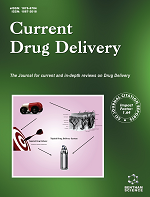- Home
- A-Z Publications
- Current Drug Delivery
- Previous Issues
- Volume 19, Issue 5, 2022
Current Drug Delivery - Volume 19, Issue 5, 2022
Volume 19, Issue 5, 2022
-
-
Release Kinetics of Hydroxypropyl Methylcellulose Governing Drug Release and Hydrodynamic Changes of Matrix Tablet
More LessAuthors: Chulhun Park, Jong H. Lee, Gang Jin, Hai Van Ngo, Jun-Bom Park, Thao T.D. Tran, Phuong H.L. Tran and Beom-Jin LeeBackground: Hydrophilic Hydroxypropyl Methylcellulose (HPMC) matrix tablets are the standard role model of the oral controlled-release formulation. Nevertheless, the HPMC kinetics for the mechanistic understanding of drug release and hydrodynamic behaviors are rarely investigated. This study aims to investigate the release behaviors of both HPMC and paracetamol (model drug) from the hydrophilic mat Read More
-
-
-
Simvastatin Nanoparticles Loaded Polymeric Film as a Potential Strategy for Diabetic Wound Healing: In Vitro and In Vivo Evaluation
More LessIntroduction: The pleiotropic effects of statins are recently explored for wound healing through angiogenesis and lymph-angiogenesis that could be of great importance in diabetic wounds. Aims: The aim of the present study is to fabricate nanofilm embedded with simvastatin-loaded chitosan nanoparticles (CS-SIM-NPs) and to explore the efficacy of SIM in diabetic wound healing. Methods: The NPs, prepared via ionic gelation, Read More
-
-
-
Eggshell Membrane Based Turmeric Extract Loaded Orally Disintegrating Films
More LessAuthors: Merve D. Köse, Nazlı Ungun and Oguz BayraktarBackground: The increasing interest in using natural bioactive compounds as new drug candidates due to their low solubility led to designing and developing novel drug delivery systems. Out of those, orally disintegrating films (ODFs) are a very eminent drug delivery system among pediatrics and geriatrics. Objective: In our study, the solvent casting method was used to prepare eggshell membrane-based and turmeric extract Read More
-
-
-
Recent Advances in the Local Drug Delivery Systems for Improvement of Anticancer Therapy
More LessThe conventional anticancer chemotherapies not only cause serious toxic effects but also produce resistance in tumor cells exposed to long-term therapy. Usually, the selective killing of metastasized cancer cells requires long-term therapy with higher drug doses because the cancer cells develop resistance due to the induction of poly-glycoproteins (P-gps) that act as a transmembrane efflux pump to transport drugs out of Read More
-
-
-
Nanotechnology-based Medicinal Products and Patents: A Promising Way to Treat Psoriasis
More LessAuthors: Faraat Ali, Kumari Neha, Kamna Sharma, Shaik Khasimbi and Garima ChauhanPsoriasis is an autoimmune skin disorder that is characterised by chronic inflammation and erythematous scaly patches. It has a significant impact on the patient's quality of life and can cause psychological stress. There are several aspects that cause psoriasis, for instance, environmental issues, immune disorders, bacterial infections, and genetic issues. Plentiful therapeutic means or treatments are accessible, but not any Read More
-
-
-
Anticancer Effect of Alginate-chitosan Hydrogel Loaded with Curcumin and Chrysin on Lung and Breast Cancer Cell Lines
More LessBackground: Cancer, which is defined as abnormal cell growth, is one of the biggest public health problems in the world. Natural compounds, such as polyphenols, are used as chemo- preventive and chemotherapeutic agents in different types of cancer owing to their antioxidant, antineoplastic, and cytotoxic properties. To improve their bioavailability and releasing behavior, hydrogel systems with high drug loadingg, stability and Read More
-
-
-
Assessment of a Novel Vitamin D3 Formulation with Nanostructured Lipid Carriers for Transdermal Delivery
More LessObjective: Develop and assess a transdermal emulsion loaded with nanostructured lipid carriers for vitamin D3 supplementation. Methods: Vitamin D3 loaded nanostructured lipid carriers, produced via high shear homogenization and ultrasonication, were assessed for their particle size, distribution, morphology, zeta potential, entrapment efficiency, and cytotoxicity. They were incorporated into a transdermal vehicle, and Read More
-
-
-
Appraisal of Felodipine Nanocrystals for Solubility Enhancement and Pharmacodynamic Parameters on Cadmium Chloride Induced Hypertension in Rats
More LessAuthors: Priyanka Maurya, Pawan Pandey, Samipta Singh, Alka Sonkar, Sonali Singh and Shubhini A. SarafAim: Felodipine (FDP), an antihypertensive drug possesses low water solubility and extensive first-pass metabolism leading to poor bioavailability. This impelled us to improve its solubility, bioavailability, and pharmacodynamic properties through the Nanocrystal (NC) approach. Methods: FDP-NC were prepared with Poloxamer F125 (PXM) by the antisolvent precipitation method. The experimental setup aimed at fine-tuning pol Read More
-
-
-
Obstructive Jaundice does not Change the Population Pharmacokinetics of Etomidate in Patients who Underwent Bile Duct Surgery
More LessAuthors: Jin-Chao Song, Xiao-Yan Meng, Hua Yang, Hao Gao, Mei-Hua Cai, Ma-Zhong Zhang and Wei-Feng YuBackground: Etomidate is commonly used in the induction of anesthesia. We have previously confirmed that etomidate requirements are significantly reduced in patients with obstructive jaundice and that etomidate anesthesia during Endoscopic Retrograde Cholangiopancreatography (ERCP) results in more stable hemodynamics compared to propofol. The aim of the present study is to investigate whether obstructive ja Read More
-
Volumes & issues
-
Volume 22 (2025)
-
Volume 21 (2024)
-
Volume 20 (2023)
-
Volume 19 (2022)
-
Volume 18 (2021)
-
Volume 17 (2020)
-
Volume 16 (2019)
-
Volume 15 (2018)
-
Volume 14 (2017)
-
Volume 13 (2016)
-
Volume 12 (2015)
-
Volume 11 (2014)
-
Volume 10 (2013)
-
Volume 9 (2012)
-
Volume 8 (2011)
-
Volume 7 (2010)
-
Volume 6 (2009)
-
Volume 5 (2008)
-
Volume 4 (2007)
-
Volume 3 (2006)
-
Volume 2 (2005)
-
Volume 1 (2004)
Most Read This Month
Article
content/journals/cdd
Journal
10
5
false
en

Most Cited Most Cited RSS feed
-
-
s Preface
Authors: Deng-Guang Yu and He Lv
-
- More Less

